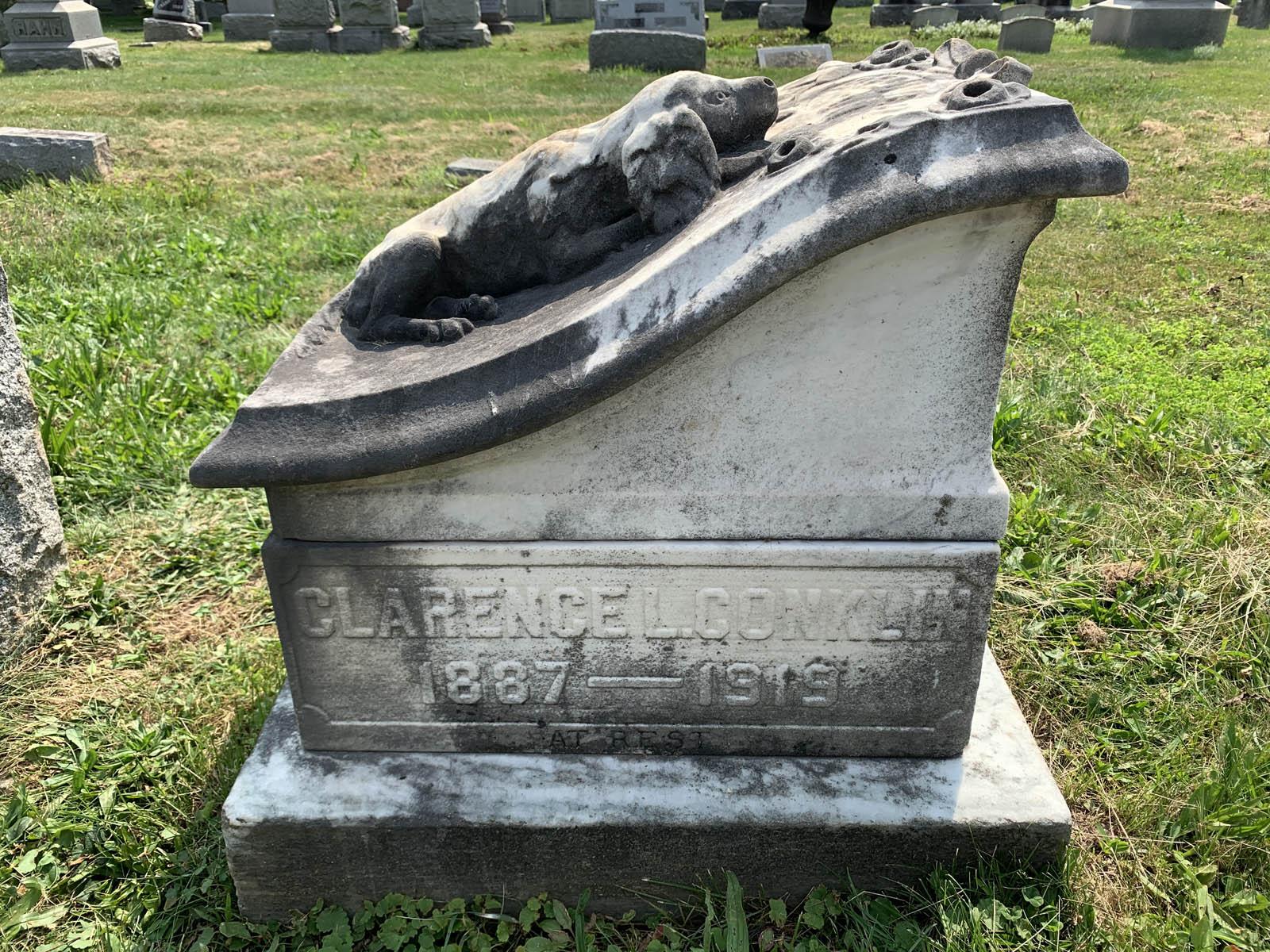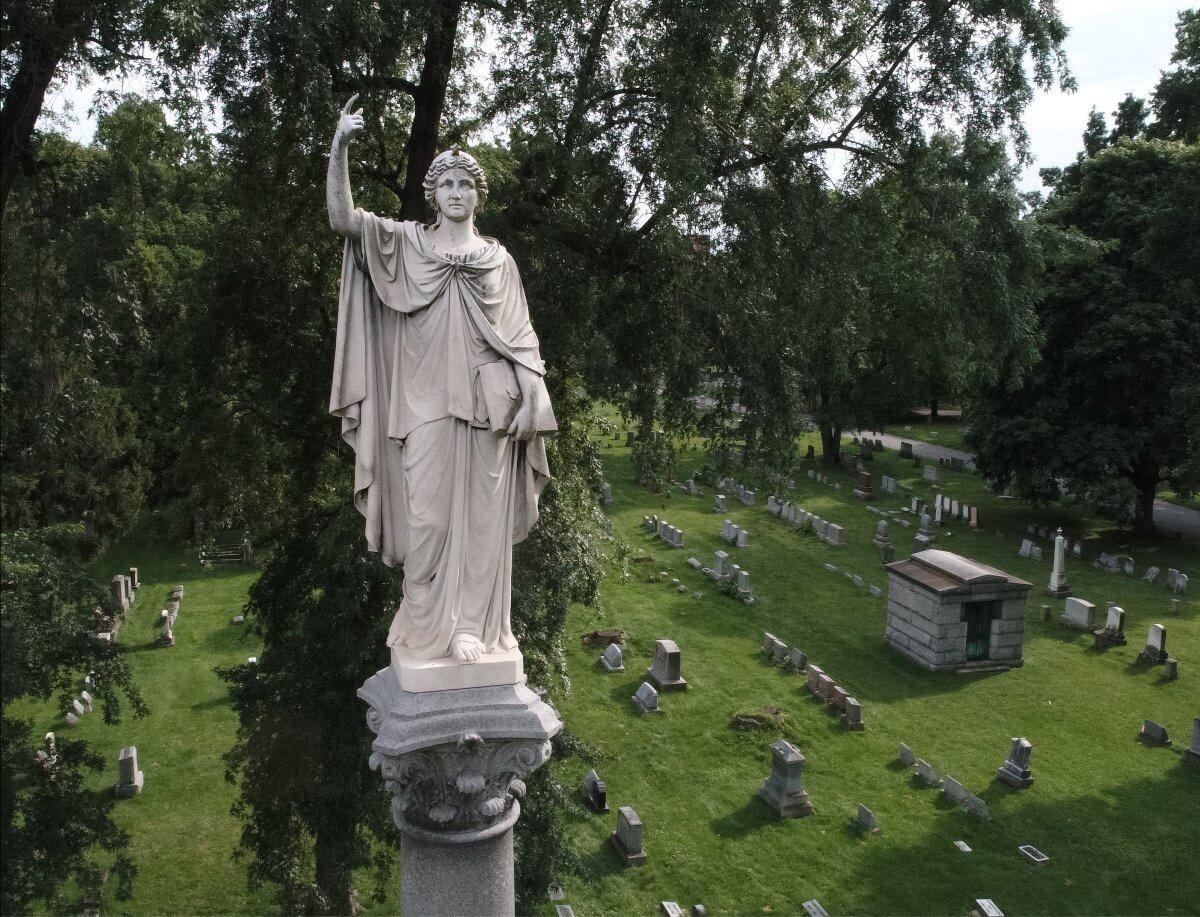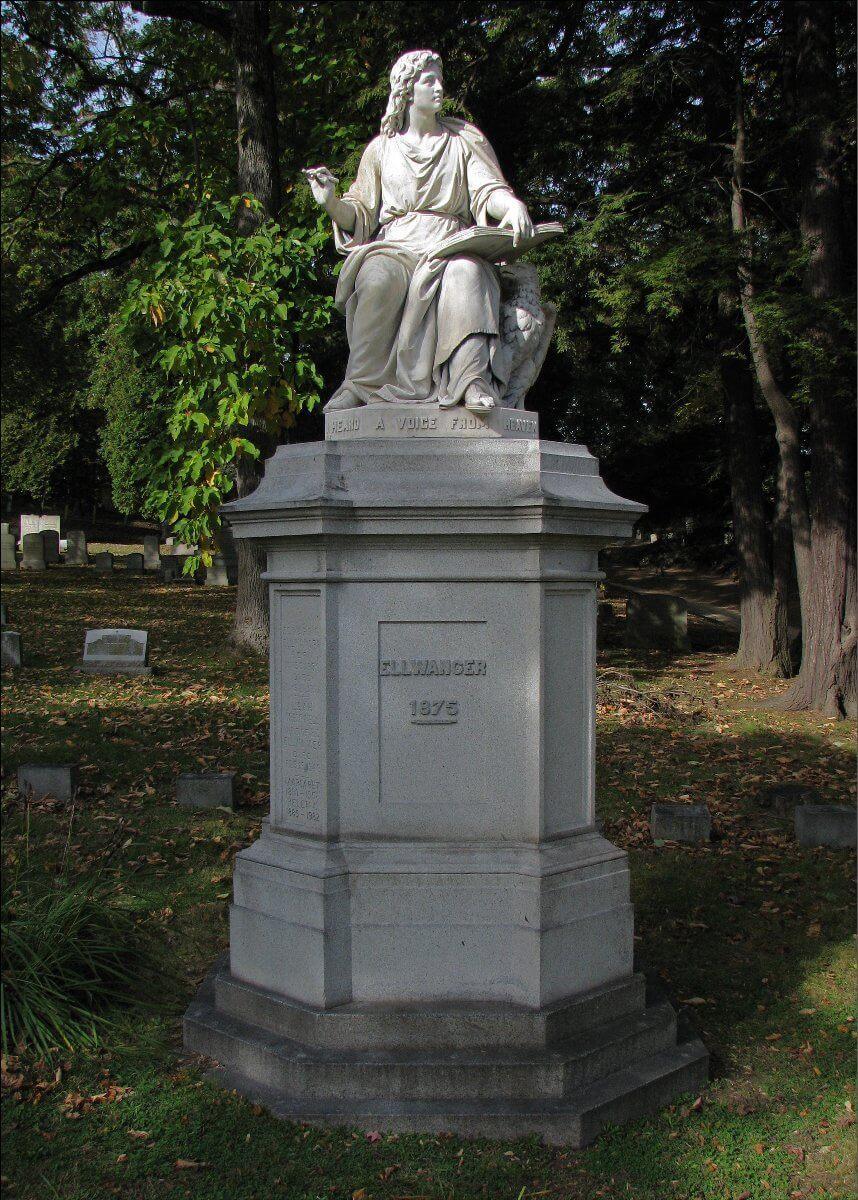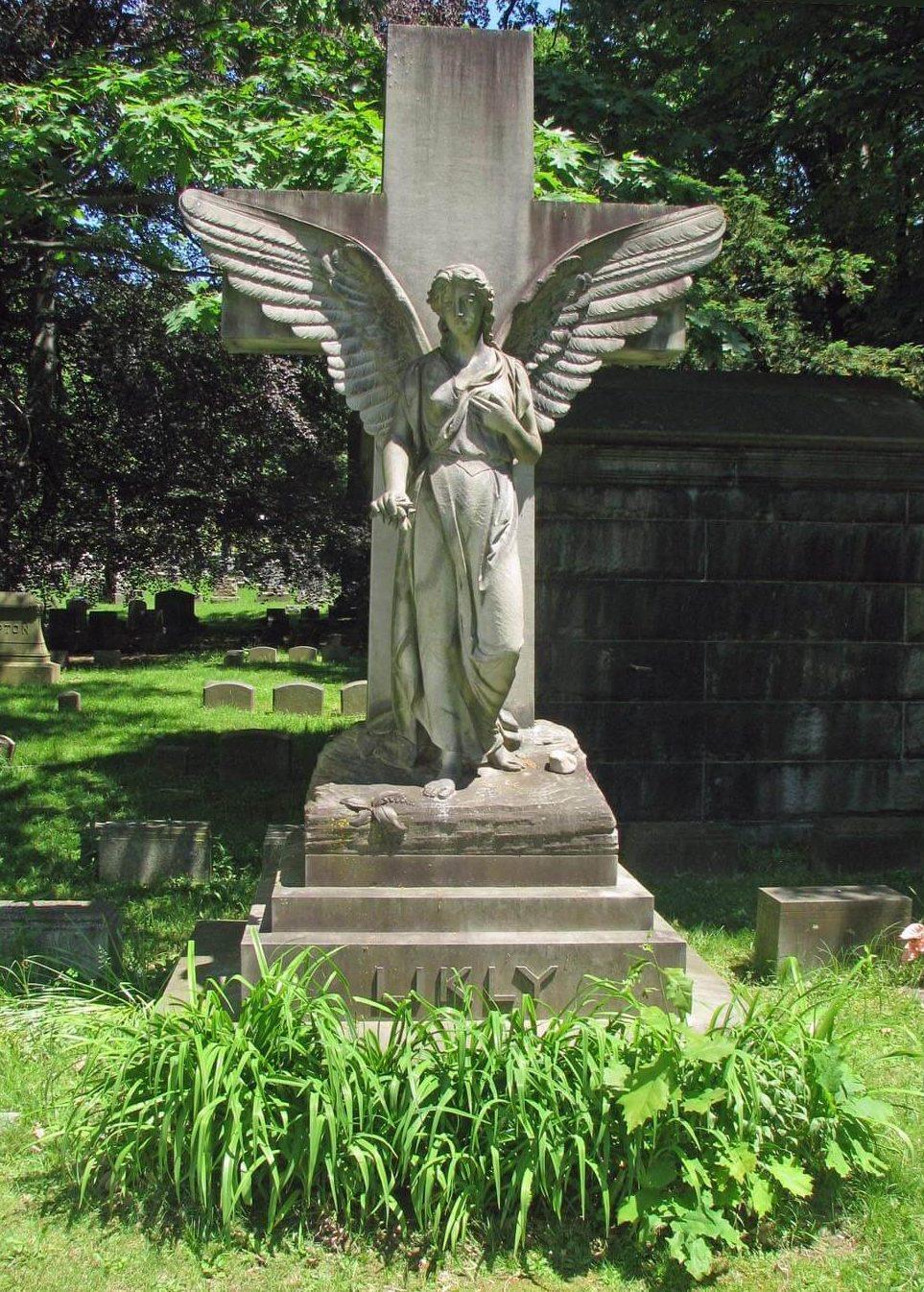America's First Municipal Victorian Cemetery

Mount Hope Cemetery, with a permanent population of over 350,000, has hundreds of thousands of gravestones with stories to tell, symbols to study, and designs to captivate. In the cemetery you will find monuments in granite, marble, limestone, sandstone, zinc, ceramic clay, and bronze fashioned into Greek temples, soaring Egyptian obelisks, ornately carved steles and columns, winged angels, bas relief portraits, stone figures in flowing robes, flora and fauna of exquisite detail in the hardest of granite. Below is a small selection of the amazing monuments that can be found in the cemetery.
Carver Monument (Range 2, Lot 104)
Ellwanger Monument (Section V, Lot 25)
Firemen’s Monument (Section BB, Lot 249)
The Weary Pilgrim (Section G, Lot 27)
Woodworth Monument (Section L, Lot 44)
E. G. Marshall Monument (Section G, Lot 193)
Kolb Monument (Section BB, lot 35)
Carver Monument (Range 2, Lot 104)

The second-highest monument in Mount Hope Cemetery has a classical design, with most of its 50 feet attained by a Corinthian column. Corinthian columns are topped with detailed Acanthus leaves, which have been used on funerary monuments since 500 B.C., symbolizing the victory of eternal life. It is decorated with mourning draperies anchored by rosettes at the base. The figure atop the monument appears to depict Faith, as she stands tall holding what may be a Bible, finger pointed upwards toward heaven, and a star on her forehead depicting divine guidance. This is a memorial to Hartwell Carver, donated by the Union Pacific Railroad in recognition of Carver’s role in proposing and planning the transcontinental railroad. One of the inscriptions reads, “He lived to see as an achieved fact what forty years before was to him a vision of the future.”
Ellwanger Monument (Section V, Lot 25)

In 1840 George Ellwanger and his partner Patrick Barry started a horticultural business across the street from Mount Hope Cemetery, destined to become the largest horticultural nursery in the United States. On the tenth anniversary of Mount Hope, he made a gift of 50 rare and valuable trees that today give Mount Hope arboretum status. He also donated the land to create Highland Park.
The Ellwanger family monument was designed and sculpted at George Ellwanger's direction by noted Italian artist Nicola Cantalamessa-Papotti in 1874. It depicts St. John of Patmos with an eagle at his side poised to write the Book of Revelations. The inscription on the sculpture reads: “I heard a voice from heaven.” This work captures the romantic feeling of the Victorian era. The imposing pedestal adds to the importance and grandeur that the Victorians sought in their cemetery monuments. St. John memorializes a deeply religious German Lutheran, George Ellwanger.
Firemen’s Monument (Section BB, Lot 249)

With the newly realized freedom in the Victorian Rural Cemetery era to choose where and how one would like to be memorialized, there are several sites at Mount Hope where people have opted to rest with fellow members of various types of organizations: religious, educational, military, or fraternal societies. One example is this firemen’s plot, dedicated in 1880 (and rededicated in 1984) by the Rochester Firefighter’s Benevolent Association. As a striking memorial to all firemen, the site’s central monument soars up to 55 feet. Carved from granite, it displays Egyptian influence with its tall obelisk design, and orb-and-wings detail as a symbol of divine protection. The fireman on top wears his distinctive hat with pride, coat on his arm, looking over that corner of the cemetery with eternal vigilance.
Likly Monument (Section L)

An angel is a messenger from God. Like most angels, this one, a female, is gentle and comforting, dropping floral petals in a tribute to the Likly family buried here. Behind the classically robed figure is a mighty cross, the preeminent symbol of the Christian religion. Henry Likly (1834-1897) was a leather merchant, first harnesses and saddles, and later in luggage and billfolds when descendants continued the business well into the latter part of the 20th century.
The Weary Pilgrim (Section G, Lot 27)


The Weary Pilgrim sits upon this monument as if he had climbed the hill, stick in hand, and laid down for a rest under a shady tree. Note the elegant detail of his face, cloak, canteen, and shell. The scallop shell traditionally was carried or worn by medieval Christians on holy pilgrimage. World-renowned sculptor Nicola Cantalamessa-Papotti (1833-1910) created the Pilgrim for the Erickson-Perkins family plot in 1882. The base has classical elements such as triglyphs and gutta along the top and was designed by architect Claude Bragdon. The patriarch of this family, Aaron Erickson (1806-1880), was a wealthy wool merchant and banker. Erickson’s daughter, Caroline Erickson Perkins (1835-1919) founded the Rochester School for the Deaf. Her husband Gilman Perkins was a founding member of the Genesee Valley Club, and the Erickson-Perkins mansion on East Avenue became the home for the organization upon Caroline’s death.
Woodworth Monument (Section L, Lot 44)


Chauncey B. Woodworth was a Rochester businessman who purchased the Rochester City and Brighton Railroad in 1868. By 1889 the railroad operated 183 cars over 40 miles of track and stabled more than 800 horses in five barns around the city. He also founded a perfume company.
His family monument is located at the top of the high iron staircase in Section L. The base of the statue represents a small building with no doors or windows, symbolizing a house for the soul in Minoan culture. At the top of this stone base is an elaborately carved robed female figure.
E. G. Marshall Monument (Section G, Lot 193)


The sarcophagus-style of monument evolved from ancient Egypt, where mummies were encased within for the spirit’s passage to the afterlife. Atop this sarcophagus is a sheaf of wheat, symbolizing the harvest of God. The wheat is wrapped by a ribbon of ivy, to show undying love. The steps leading up to the monument convey the importance of the deceased, in this case Civil War General E. G. Marshall (1829-1883) of the Union Army. A West Point graduate, Marshall was a classmate of General Robert E. Lee. When captured by the Confederate Army after leading a Union assault at Petersburg, he asked for a meeting with General Lee. Lee did grant Marshall the favor of retaining his belongings, though Marshall was imprisoned for the rest of the war.
Kolb Monument (Section BB, lot 35)


Bronze plaques on two red granite blocks depict bas relief sculptures memorializing Alphonse Anton Kolb (1893-1938) and his two wives: Elfrieda (1877-1945) and Kathryn (1887-1968). Elfrieda’s plaque shows a lovers’ boat, the man serenades his embracing partner with a guitar; the boat is steered by a putto in the stern, and another directs it in the bow. Kathryn’s plaque portrays Christ bearing his cross to Golgotha. Alphonse Kolb was an accomplished sculpture who for 50 years worked for Bastian Brothers Company, striking metal dies for medals and plaques.
Van Hoesen Monument (Section MM, lot 200)


The focal point of this monument is a breathtaking engraved sculpture of an angel with uplifted wings, holding a memorial wreath, one foot peeking out from underneath her graceful garments. The wreath is a symbol of victory, honor, and eternal love. The biblical verse, written in an Art Nouveau type style, reads “Yea, saith the Spirit, that they may rest from their labours; and their works do follow them.” The symmetrical rosettes, dentil detailing, and Scipio-style top form a frame for the sculpture. Frank P. Van Hoesen (1862-1937) owned a business in downtown Rochester specializing in paints, wallpaper, window shades, and Venetian blinds.
Filon Monument (Section D)


This massive gray granite family monument is composed of elements that resemble a classically designed architectural structure topped with a pair of sculptured figures. Above the stone base is a rectangular wall containing the inscriptions. On the corners are squat fluted pilasters with Ionic capitals. The cornice is decorated with a Greek dentil motif. Above the first roofline, there is a classical guilloche, a repetitive architectural pattern, running along the platform base for the sculptures above. And finally, transcending it all, are two life-size female figures, one representing Hope, who is consoling Sorrow, who is sitting beside her. All of it memorialized Michael Filon (1820-1893) and his wife Sarah Vanness Filon (1822-1871). Filon was a carriage maker, pioneer real estate investor, and Rochester mayor in 1862-1863.
Revolutionary War Monument (Section BB)


Rocks represent permanence, stability, reliability, and strength. Psalm 18.2: “The Lord is my rock, and my fortress, and my deliverer, my God, my strength…” Here, a bronze plaque on a massive stone boulder memorializes members of Gen. John Sullivan’s army on a scouting mission, who were killed Sept. 13, 1779. Capt. Lieut. Thomas Boyd (1756-1779) and Sergeant Michael Parker (c. 1754-1779) were captured by Seneca Indians and killed in night-long ritualistic tortures.
Alexander Millener (Range 2)


This cast-zinc metal monument forms a three-dimensional structure with architectural details like an arched and colonnaded porch, Ionic corner columns, and overhanging roof. Inside the left arch is a lily of the valley, symbolizing innocence and purity. Because it blooms early in spring, it also stands for renewal and resurrection. In the right arch is a floral wreath symbolizing victory, honor, and memory. Buried here is Alexander Millener (1762-1865) who was Gen. George Washington’s drummer boy and died at the advanced age of 103 years.
Clarence L. Conklin (Section BB)


Dogs, as man’s best friend, accompany their master to the cemetery, and there are a number of them in Mount Hope Cemetery. This marble dog, the cherished pet of 32-year-old Clarence L. Conklin (1887-1919) lies on an inclined surface so that his eyes look upward to heaven where his master has gone.
Solomon Levy (Range 5)


A white marble sarcophagus rests on four lions’ paws. The top of the coffin bears the Freemason’s symbol of the compass and square. Hebrew letters appear on the opposite face of the sarcophagus, and it is interesting that although few Jews became Masons nationally, in Rochester an unusually large number of Jews joined the lodge. Solomon Levy (1826-1898) rests here, but maybe not peacefully, considering the inscription involving ingrates.
Peter Yost & Gustav Schaub (Section MM)


This tall gray granite pillar starts at the base as a square block, but soon the block is chamfered to create an eight-sided towering column with a cap at the top. The upper portions of the eight faces have vines engraved into them. Vines represent everlasting love, and there is a lot of love in this family monument that memorializes the Peter Yost (1808-1871) and Gustave Schaub (1875-1945) families.
James Brackett (Section V)


This Gothic style baldachin, supported by four round, polished red granite columns and richly decorated capitals, provides a stone canopy over a classically robed statue of a woman with her head in mourning and her arms embracing a large Christian cross. The baldachin incorporated pointed Gothic arches and a steeply gabled roof topped by another stone cross. The elaborate monument was erected for James Brackett (1818-1904) and his family. Brackett was a distinguished Rochester citizen who became the city’s 30th mayor, serving in 1864-1865.
George Newell (Section C)


The statue atop this monument is graceful, and the folds of her gown appear as if she’s in motion. She carries a garland of many flowers, each representing different emotions; for example, roses (hope, heavenly joy) and morning glories (brevity of life, resurrection). It was sculpted by James W. Pollette of the Smith Granite Company in Westerly, R.I., one of the most prestigious monument suppliers of its time. George Newell (1828-1892) was the founder and president of the Empire Moulding Works. While serving on the Rochester Board of Park Commissioners, Newell negotiated the purchase of land that would become Seneca Park.
William Rossiter Seward (Section F)


This artistic monument features a female carved in bas relief. Her facial expression looks mortal yet her robes fan down like angel’s wings, and she holds an eternal flame. This Art Deco style stone was designed by prominent architect designer Claude Bragdon. William Rossiter Seward (1834-1926), banker and philanthropist, financed the Brotherhood Church of the Rev. Algernon Sidney Crapsey in 1906, after Crapsey was excommunicated from the Episcopal Church for his heresy of progressive views.
Wilbur Barry Coon (Section MM)


This massive, 12-foot-high, Art Deco granite monument was created by Tiffany Studios, New York City, in 1927. It required a specially built railroad car to transport the huge, heavy stone to Rochester. It depicts a winged angel looking and gesturing toward heaven while a dove, a symbol of purity and peace, flies above. Wilbur Barry Coon (1870-1926) afforded this lavish memorial by manufacturing shoes, especially women’s and children’s shoes, but also for soldiers in the first World War. At one time, Coon provided shoes to over 8,000 retail dealers abound the world.
Henry Rosenberg (Range 3)


This “double” or “cathedral” gravestone is usually used for spouses, encompassing the idea that a married couple remains united in death for eternity. One Mount Hope example of this style has a biblical quote, “They who lived together in love and sweetness, were not divided in death”. A Gothic influence is seen as the separate pillars triangulate up to a pointed top. There are stone beds built out in front of the headstone, which appear to be a German tradition. Henry Rosenberg (1824-1884) had a jewelry and fine silver shop, which sold beautiful objects to affluent Rochester families. Also active in the community, the emblems of the Freemasons and the Odd Fellow fraternal organizations are etched in the top of the monument. His wife Frederica (1836-1865) passed at age 29, shortly after giving birth.

These monuments are featured in our publication titled Gravestones. This popular book includes 130 pages of gravestone photographs and descriptions. A hike through Mount Hope will reveal many more notable and interesting memorials. Gravestones is available in our Gift Shop.
Information on this webpage is from Gravestones in Mount Hope Cemetery, Rochester, New York, Richard O. Reisem, editor, The Friends of Mount Hope Cemetery (2012). The text is used with permission of Richard O. Reisem and the Friends of Mount Hope Cemetery.




